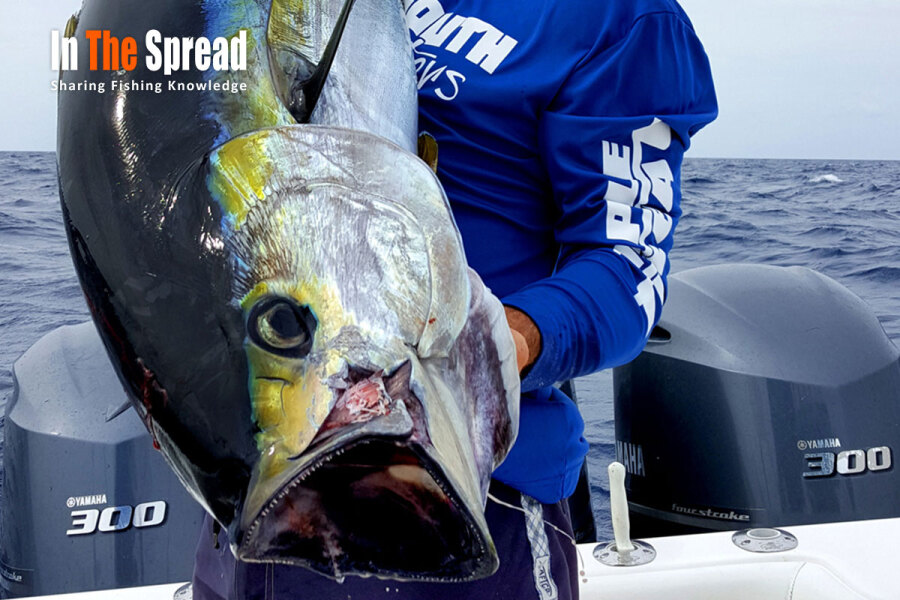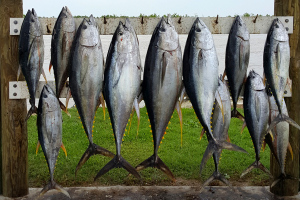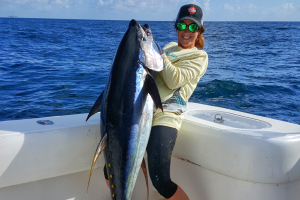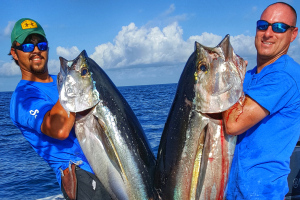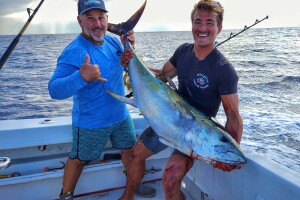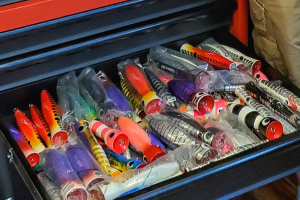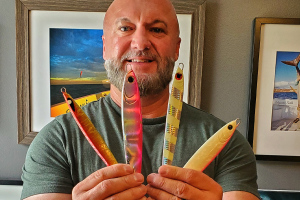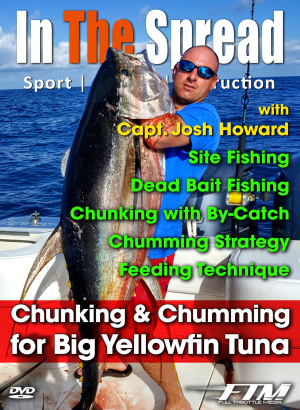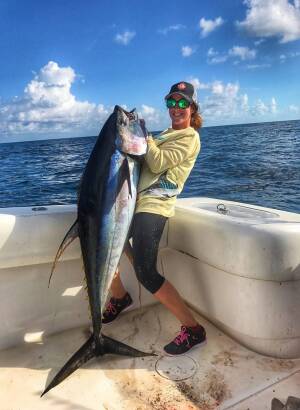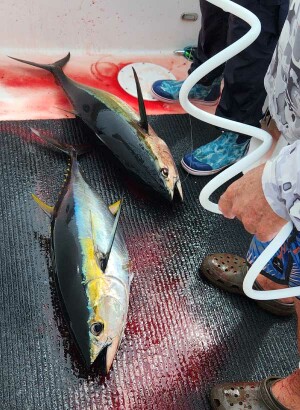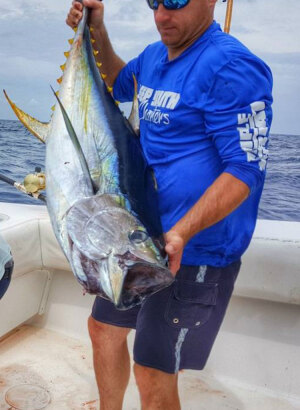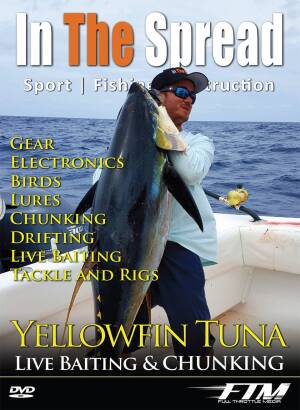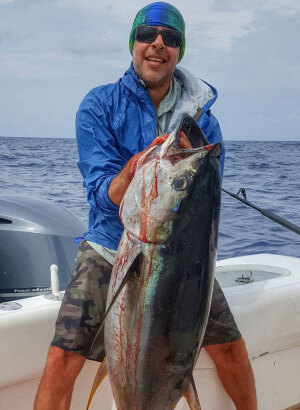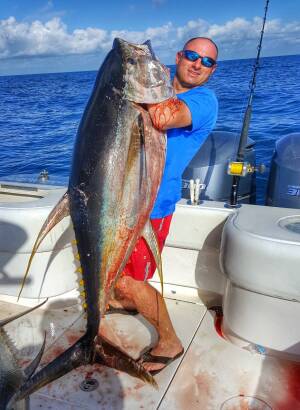Venice, Louisiana transforms from a simple river delta into yellowfin tuna fishing paradise when you understand the proven techniques. Captain Josh Howard has perfected chunking and chumming methods that consistently attract these Gulf giants. His time-tested strategies, refined through years of reading water conditions and tuna behavior, turn challenging pursuits into successful catches.

Chunking and Chumming for Big Yellowfin Tuna
Summary Points:
- Location: Venice, Louisiana - a prime spot for yellowfin tuna fishing.
- Expert Guidance: Insights from Capt. Josh Howard, a master of chunking and chumming techniques.
- Fishing Techniques: Detailed strategies for chumming and chunking, tailored for yellowfin tuna.
- Tuna Behavior: Understanding tuna responses to bait and fishing conditions.
- Tackle and Gear: Recommendations for hooks, setups, and equipment for successful tuna fishing.
- Environmental Factors: The role of water conditions and moon phases in tuna fishing.
- Fishing Experience: Emphasizing the journey and learning experience in tuna fishing.
Venice, Louisiana, is not just a geographical location where the mighty Mississippi River greets the Gulf of Mexico; it's a haven for those who are passionate about yellowfin tuna fishing. The local captains and crews, including the renowned Capt. Josh Howard, have perfected the art of fishing in these dynamic waters. Their expertise lies in mastering the delicate balance between man, bait, and the elusive yellowfin tuna.
Master Yellowfin Tuna Fishing
The Art of Chunking and Chumming
In the world of yellowfin tuna fishing, two techniques stand out: chunking and chumming. Capt. Howard, a virtuoso in these methods, uses the by-catch from trawl boats to create an irresistible trail for the tuna. This simple yet effective technique transforms the angler into a magnet for yellowfin tuna, promising an adrenaline-fueled catch.
The key to successful chumming is not just about quantity but about understanding the tuna's behavior.
Capt. Josh HowardChumming Strategy
Capt. Howard's chumming technique is a masterclass in precision and timing, perfected through years of experience in the Gulf of Mexico. His strategy hinges on creating an enticing trail of by-catch and frozen baits, meticulously deployed to captivate the elusive yellowfin tuna. Understanding the delicate balance between frequency and quantity of chumming is pivotal. Too much bait can lead to overfeeding, while too little can lose the fish's interest.
Howard's method involves a steady dispersal of chum to maintain a constant presence in the water. This not only attracts tuna but also keeps them engaged and active around the boat. The idea is to mimic a natural feeding scenario, tricking the yellowfin into believing that they have stumbled upon a plentiful food source.
Using by-catch as chum is both an effective and sustainable practice. These are typically the unintended catches from trawl boats, which would otherwise go to waste. By repurposing them, Howard turns potential waste into an effective lure. The variety in the by-catch also mirrors the natural diet of the yellowfin, making the chum trail even more appealing.
Frozen baits, often a mix of smaller fish species, complement the by-catch. They are used strategically, thawed and chopped into sizes that are large enough to attract attention, but not so large as to satisfy hunger quickly. This ensures that the tuna linger around the boat, searching for more.
The real skill in Capt. Howard's chumming lies in his ability to read the behavior of the fish and the conditions of the water. He adjusts the chumming rate based on the tuna's response, water clarity, and current strength. If the fish seem disinterested or drift away, he increases the chumming frequency. Conversely, if the fish are feeding aggressively, he moderates the bait dispersal to keep them keen and close.
In essence, Capt. Howard's chumming approach is an art form, requiring patience, observation, and a deep understanding of the yellowfin tuna's habits and preferences. This technique not only enhances the likelihood of a successful catch but also enriches the overall fishing experience with a deeper connection to the marine environment and its inhabitants.
Chunking Techniques
Chunking, a technique as intricate as it is effective, demands an in-depth understanding of the target species, in this case, the yellowfin tuna. The crux of chunking lies not only in the choice of bait but also in how it's presented. This method has been refined over the years by seasoned anglers like Capt. Howard, who have developed a keen sense of what works best to attract the larger, more prized yellowfin tuna while minimizing the attention of smaller, less desirable species.
Selecting the Right Bait
The choice of bait in chunking is critical. Larger baits are generally more effective for several reasons. Firstly, they are more visible and enticing to larger tuna, which are looking for a meal that is worth their effort. The bait needs to be substantial enough to appeal to their predatory instincts. Typical choices include larger fish species such as mackerel, herring, or even parts of skipjack tuna. The size and type of bait used can significantly impact the size and quality of the tuna attracted.
Preparation and Presentation
Preparation of the bait is where the nuanced understanding comes into play. The bait must be cut into chunks that are large enough to attract big tuna but not so large as to be easily snatched away by smaller fish. This requires a delicate balance, as overly large pieces might deter the tuna from biting, thinking it's too big to handle, while too small pieces might attract unwanted species.
Capt. Howard's method involves cutting the bait into optimum sizes and presenting it in a way that mimics injured or vulnerable prey. This is often achieved by ensuring the chunks drift naturally with the current, resembling the movements of wounded fish. The presentation is crucial; it's not just about dropping bait into the water but strategically placing it to create a trail that leads the tuna directly to the fishing zone.
Timing and Technique
Timing is also a vital aspect of chunking. It's not just about throwing chunks overboard but doing so at intervals that keep the fish interested without overfeeding them. The chunks need to be dispersed in a way that creates a consistent trail, leading the tuna towards the boat and keeping them in the area. This requires patience and a good understanding of the tuna's feeding patterns.
Avoiding Smaller Catches
One of the challenges of chunking is avoiding smaller, less desirable species. This is where the skill in bait selection and presentation truly shines. By using larger chunks and presenting them in a specific manner, experienced fishermen like Capt. Howard can selectively target the larger yellowfin tuna. The idea is to make the bait less accessible to smaller fish either by size or by how it's presented in the water.
Chunking in Summary
In summary, chunking is a sophisticated technique that requires not just knowledge of the tuna's preferences but also a deep understanding of how to manipulate these preferences to the angler's advantage. Capt. Howard's method, honed through years of experience, demonstrates the importance of bait selection, preparation, presentation, and timing in successfully attracting large yellowfin tuna while minimizing the catch of smaller, less desirable fish. This approach not only increases the chances of landing a trophy fish but also contributes to the sustainability of the sport by targeting specific species and sizes.

Tackling the Gulf's Giants
When engaging in the challenging pursuit of yellowfin tuna, especially through the method of chunking, the significance of having robust and reliable gear cannot be overstated. Capt. Howard, with his wealth of experience, lays particular emphasis on several critical components of the gear, each playing a pivotal role in the success of the fishing endeavor.
Hooks for Chunking Tuna
The choice of hooks is foundational in chunking for yellowfin tuna. These hooks need to be strong enough to withstand the immense power and speed of the yellowfin, which are known for their spirited fights and incredible strength. Capt. Howard recommends using heavy-duty, corrosion-resistant hooks that can endure the harsh saltwater environment and the tuna's forceful pulls. The size and shape of the hook also matter. Circle hooks are often preferred in chunking because they tend to hook the fish in the corner of the mouth, which is ideal for catch-and-release practices and ensures a more secure hook-up.
Tuna Chunking Setup
The overall setup for tuna chunking is another area where robustness is key. This setup includes the rod, reel, line, and leader. For the rod, a medium to heavy action is ideal, offering the necessary strength and flexibility to handle large tuna. The reel should be a high-quality, high-capacity model, capable of holding enough line (often braided for its strength-to-diameter ratio) to endure long runs that yellowfin tuna are famous for. The drag system of the reel must be smooth and reliable, as inconsistent drag can lead to broken lines or lost fish. As for the leader, a fluorocarbon leader is often preferred due to its near invisibility in water and abrasion resistance, essential qualities when dealing with the keen-eyed yellowfin tuna.
Reel Settings and Bait Presentation
Finally, the nuances of reel settings and bait presentation are crucial in chunking for yellowfin tuna. The reel's drag setting should be meticulously adjusted to be tight enough to set the hook firmly but not so tight as to snap the line during a powerful run. This delicate balance requires a deep understanding of the reel's capabilities and the strength of the line being used.
Bait presentation is equally vital. The bait must appear natural and enticing to the tuna. This involves ensuring that the chunks of bait drift in a realistic manner, mimicking injured or disoriented prey. The way the bait is hooked plays a significant role in this. It needs to be secured enough to stay on the hook but not so much as to hinder its natural movement in the water. Capt. Howard's expertise shines through in his ability to present bait in a manner that is almost irresistible to yellowfin tuna.
In summary, each aspect of the gear - from the hooks to the overall setup, and the nuances of reel settings and bait presentation - plays a critical role in the challenging pursuit of yellowfin tuna. Capt. Howard's emphasis on these elements highlights their importance in not just attracting and hooking the fish but also in successfully landing them, a testament to his deep understanding and respect for these formidable creatures of the sea.
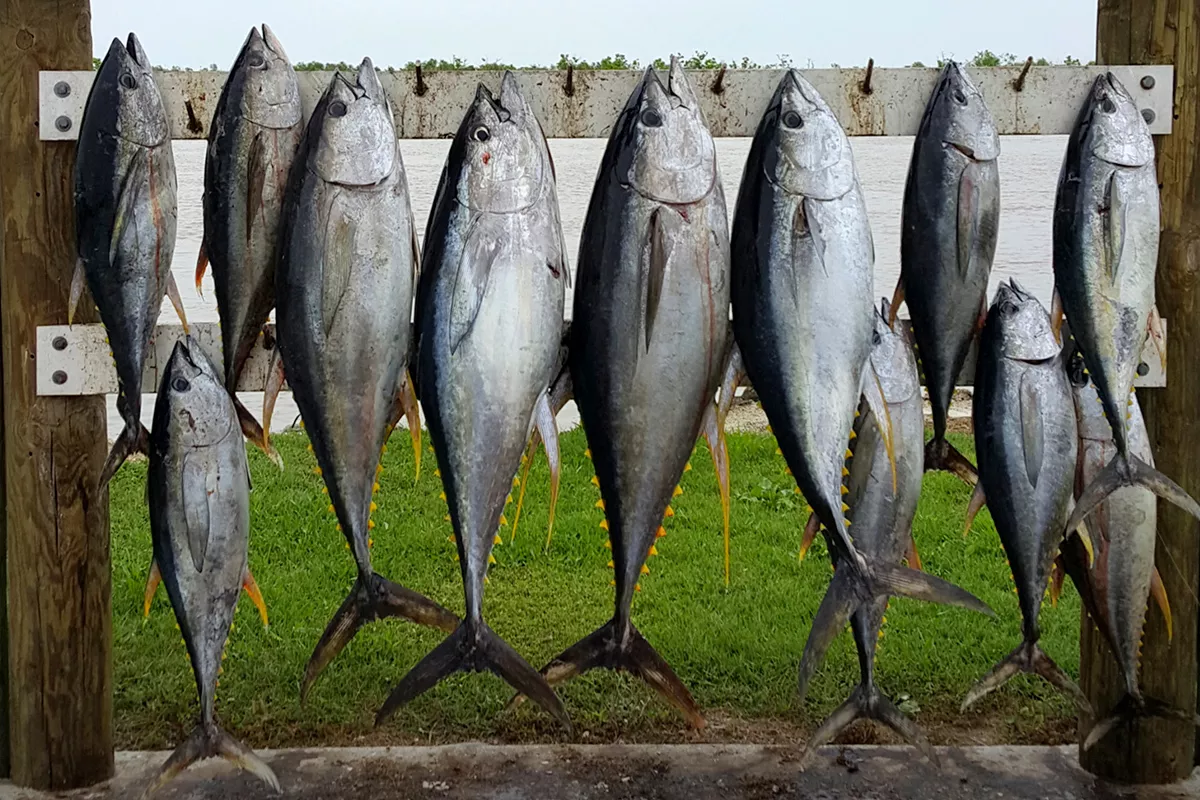
Navigating the Waters
Fishing in Venice, Louisiana, especially for the formidable yellowfin tuna, transcends the act of merely casting a line into the water. It's a complex interplay with the environment, requiring an angler to be in tune with various aspects of the marine ecosystem. Capt. Howard, a seasoned expert in these waters, knows that success in these endeavors hinges on understanding and adapting to the ever-changing dynamics of the Gulf of Mexico.
Understanding Trawl Boat Patterns
One of the key aspects of fishing in Venice involves recognizing and interpreting the patterns of trawl boats. These boats, often engaged in shrimp or other types of fishing, inadvertently create feeding opportunities for predatory fish like the yellowfin tuna. Anglers like Capt. Howard keep a keen eye on the movement of these trawl boats, as their by-catch and the trail they leave behind can attract schools of tuna. Understanding the timing and areas where these boats operate allows anglers to position themselves advantageously, increasing the chances of a successful catch.
Utilizing Electronics for Spotting Fish
Modern fishing is greatly enhanced by technology, particularly the use of sophisticated electronic equipment. Sonar, GPS, and fish finders are invaluable tools in locating schools of tuna. These devices help in identifying underwater structures, temperature breaks, and baitfish schools, all of which are potential indicators of yellowfin tuna presence. By interpreting the data these electronics provide, anglers can make informed decisions on where to fish, effectively increasing their odds of locating and catching tuna.
Water Conditions
The conditions of the water are pivotal in determining the presence and behavior of yellowfin tuna. Two key factors in this regard are water color and temperature.
- Water Color: Clear, blue water is often preferred for tuna fishing as it allows tuna to see the bait more clearly. Murky or greenish water can make it difficult for tuna to locate the bait, reducing the likelihood of a catch.
- Water Temperature: Yellowfin tuna prefer warmer waters, typically between 72°F to 82°F (22°C to 27°C). Anglers use temperature gauges to find the ideal water temperature, which often indicates the presence of tuna. Temperature breaks, where warm and cool waters meet, can be particularly productive areas.
Moon Phases
The lunar cycle's influence on fishing, especially for species like the yellowfin tuna, is well documented and respected among anglers. The moon phase affects various aspects of the marine environment, which in turn influences fish behavior.
- Tidal Movements: The moon's gravitational pull affects the tides. High tides can bring yellowfin tuna closer to shore or to certain structures where baitfish congregate, while low tides can concentrate fish in deeper waters.
- Feeding Patterns: Many anglers have observed changes in fish feeding patterns during different phases of the lunar cycle. Some phases, particularly around the full moon, seem to enhance feeding activity in yellowfin tuna.
In conclusion, fishing in Venice is an intricate dance with nature. It involves understanding the nuances of the environment, from the patterns of trawl boats and the use of electronics in locating fish, to the critical roles played by water conditions and lunar phases. For anglers like Capt. Howard, this deep comprehension of the Gulf's ecosystem is not just a path to successful fishing but a testament to their respect and connection with the marine world.
Embracing the Fishing Journey
In Venice, Louisiana, every excursion onto the water transcends the mere act of fishing; it's an immersive educational journey. This ethos is deeply embodied in the practices of experienced fishermen like Capt. Howard, who view each trip as an opportunity for growth, discovery, and a deeper connection with the sea and its inhabitants. For Howard and many like him, fishing is a narrative, with each outing adding a new chapter, rich with lessons and experiences.
One of the key learning aspects in Venice’s waters involves honing the skill of observation. Each trip allows anglers to observe and understand the subtle signs of nature – the behavior of seabirds, the patterns of the waves, the color of the water, and the direction of the wind. All these elements, often overlooked, are crucial in understanding the marine ecosystem and predicting the presence of fish like yellowfin tuna. Capt. Howard, with years of experience, teaches the importance of interpreting these natural indicators, a skill that enhances not just the chances of a successful catch but also fosters a deeper respect for the ocean's intricacies.
Every fishing trip in the Gulf of Mexico is a lesson in adaptability. The marine environment is in a constant state of flux, influenced by factors like weather, water temperature, and currents. What worked one day might not work the next. Capt. Howard's experiences serve as invaluable lessons in flexibility and adaptation. He teaches both novice and seasoned anglers how to adjust tactics, from choosing the right bait to modifying the fishing technique, based on the prevailing environmental conditions.
Another crucial aspect of learning in Venice’s fishing expeditions is mastering the tackle and technique. Each trip with Capt. Howard is an opportunity to learn about different fishing gears, from rods and reels to lines and hooks, and how to use them effectively. More importantly, it's about understanding the why behind each choice – why a certain hook size is better for chunking, or why a specific reel setting is ideal for battling a large yellowfin. This knowledge is crucial, as it can mean the difference between a memorable catch and a lost opportunity.
Capt. Howard’s years on these waters have also imparted a deep understanding of the target species – their habits, preferences, and behaviors. Every trip provides insights into the world of yellowfin tuna, their feeding patterns, migration routes, and reactions to different baits and techniques. This knowledge is not just practical for better catches but also instills a sense of admiration and respect for these majestic creatures.
Perhaps the most poignant lesson from fishing in Venice is the appreciation of the story each journey tells. It's not just about the number or size of fish caught, but about the experience – the early morning starts, the camaraderie among anglers, the thrill of the chase, and the serenity of being on the open water. Capt. Howard’s stories, filled with triumphs, challenges, and surprises, are a testament to the fact that every trip is unique, offering its own set of lessons and memories.
In summary, fishing in Venice, Louisiana, under the guidance of seasoned anglers like Capt. Howard, is much more than a recreational activity. It's a comprehensive learning experience, offering lessons in observation, adaptability, technique, and a deeper understanding of the marine ecosystem. Each trip is a narrative, rich with knowledge and stories, waiting to be discovered and cherished.
Learn more by watching selections from our extensive library of yellowfin tuna fishing videos

